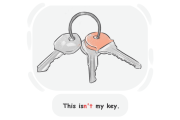Apostrophe
In this lesson you will learn how to use apostrophes for singular and plural possession. Practice with helpful examples and exercises to improve your skills.

What Is an Apostrophe?
An apostrophe (') is a punctuation mark that is used to indicate possession or to show where letters or numbers have been omitted in a contraction.
Apostrophe: Uses
An apostrophe can be used in different cases, such as:
Replacing Missing Letters
While making contracted forms, we usually delete some letters which can be only one letter or more than one letter. In both cases, we use only one apostrophe in place of the missing letters. Here are a few examples:
This isn't my key.
In this example, the long form is 'is not' but we have contracted it by omitting the letter 'O' and replaced it with an apostrophe to create 'isn't'
We can't find him anywhere.
In this example, apostrophe replaces two letters because we omitted 'no' and used an apostrophe instead.
In the '60s many great songs were released.
Here by '60 we mean 1960


Making Possessive Nouns
When the owner of something is a noun, we can usually use an apostrophe plus an 's' to show possession. Here are some examples:
Sarah's father has a limo.
The manager's reports were on the table.
If there is a plural noun or a singular noun ending in '-s' or '-es', you should use only an apostrophe to show possession or ownership. Here are the examples:
The schools' policies are getting established.
All brides' wishes are to be healthy and happy for the rest of their lives.
Making Plural Letters
Sometimes, there is a need to use plural numbers, letters, interjections, abbreviations, or conjunctions; however, they are not used with the same intention. In this case, we use an apostrophe. Here are a few examples:
There are too many and's in your text.
There were lots of M's in his name.
When Not to Use an Apostrophe
Remember not to use 's when you are using possessive pronouns.
❌It was her's car.
❌This is his'es toy
Tip
Use 's for irregular plural possessive nouns. For example:
Their feet's toes were cold.
It's or Its
It's is the contracted form of 'it is' and thus it has an apostrophe; but its is a possessive determiner and does not need an apostrophe. Here are the examples:
It's not important what you think of me.
Its tail is curved and brown.
Review
Mostly, we use the punctuation (') (also known as apostrophe) in three major situations:
to show possession
to show contraction
to use unusual plural letters, numbers, etc.
Comments
(0)